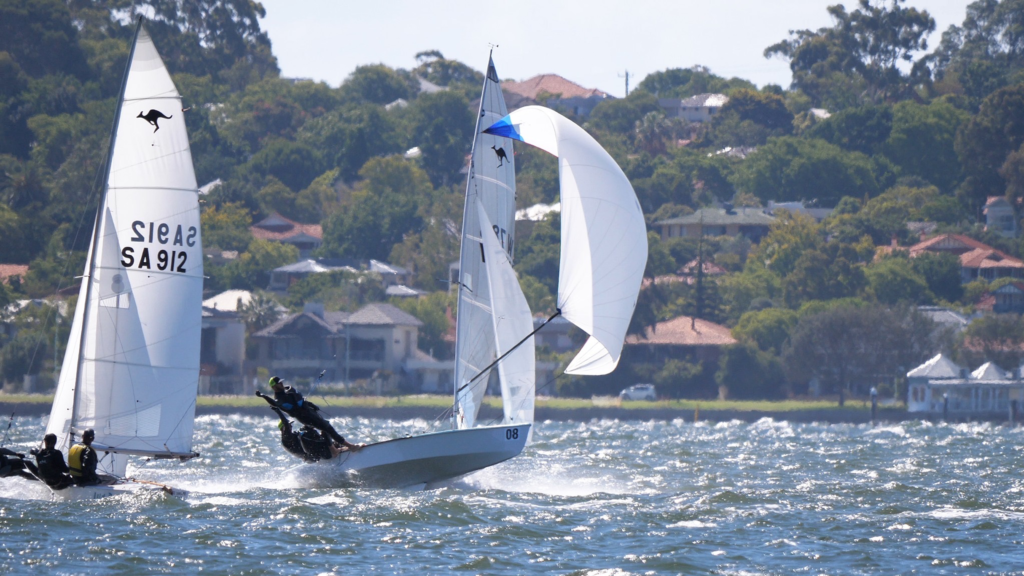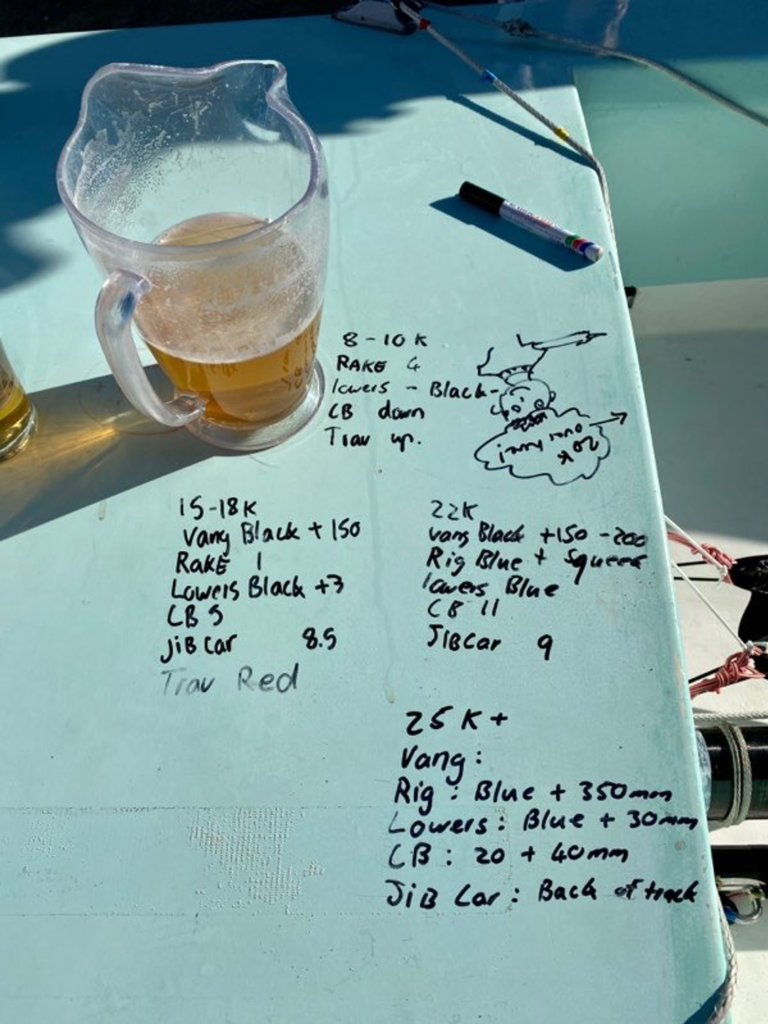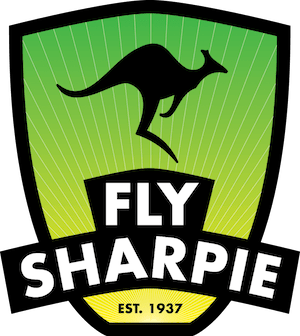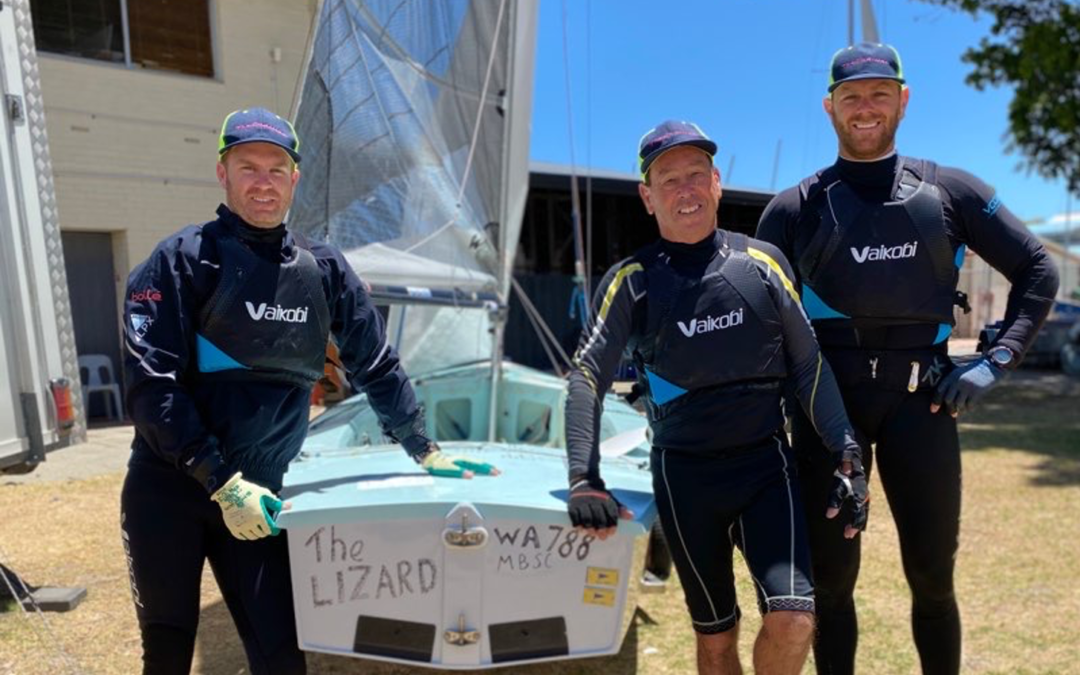I have to start by saying that I had forgotten how much fun the Sharpie class is, both on and off the water!
I am by no means a technical expert in the Sharpie class, Pete Chappell can take on that title. The real technical expert is ‘The Lizard’ because she is the one that lets us write all over her, stitch marks in her ropes and calibrate all her bits and bobs.
Everything we need to remember about setting up the boat is already written on it. Our notes on the boat might look like the carvings from a caveman but they actually mean something to the cavemen onboard.
Here are my tips and tricks from 2019/20 Sharpie Nationals at Mounts Bay Sailing Club in Perth.
- Boat: The Lizard, WA 788 (built ca. 1991)
- Crew: Pete Chappell (helm), Pete Nicholas (sheethand) and Luke Payne (forwardhand)
- Sails: Walker (new jib, the rest from 2014 Nationals)
- Foils: Concept Fibres (new for the nationals)
- Mast: Selden Stratus
There is nothing super special in our rig tuning. From what I have seen and heard our rake and tensions are pretty similar to tuning guides, our spreader angle hasn’t changed in 20 years.

Tip 1: KEEP THE BOAT FLAT!
Tip 2: refer to tip 1
Tip 3: refer to tip 2
In all seriousness, this is the most important thing about sailing Sharpies or any other similar dinghy.
It can never be emphasised enough and it should pretty much be the number one focus of the sheethand at all times while racing. Even more important when its windy and flat water, like it generally is on the Swan River.
There must be good communication between the helm and sheet about flatness. Basically once we are planing upwind I am playing about 3 to 5 inches of mainsheet, trying to anticipate the gusts and lulls and watching the jib.
The sheethand is effectively steering the boat upwind when it’s windy, for example if you are dead flat but too low, talk to the helm so they can steer up as the sheethand sheets on. That pumping feeling with the mainsheet is not fast, it is more a sign that the sheethand and helm are a little out of whack.
Tip 2: Mark everything
The Lizard hadn’t been sailed in any real anger since the last nationals in Perth in 2014, but all the settings were still there on the back deck in permanent marker.
We had made pretty good notes (uploaded to Google Drive) for our crew mechanics, who does what in the pre-start, in tacks, in gybes, sets, drops and all that sort of stuff.
We also have most of our rig settings colour-coordinated, for example, 25+ knots is blue, put rake to blue mark, lowers to blue, inners blue, side stays blue… you get the point.
It may take you a while to get all these marks setup but once it is done it gives you a good base to work around. When nothing seems to be adding up just go back to your marks for that wind range. It is also important to have good marks on your jib sheets and jib cars. Basically mark everything you can.

Tip 3: Know how to de-power
In flat water you can carry more rake to de-power. Raking back is our first de-powering tool when on the river. Board is also very important and if you can see a big gust coming and don’t have time to mess with the rake, just pop a bit of board.
We generally carry the mast one inch more upright and the board two inches further down for the start. This gives you the option for a high groove and a bit more grunt to get over someone to leeward. Once in clear air and clean lane go to your fast settings.
During the nationals we ended up running slightly tighter side stays than normal, probably due to flat water and the fact that it was an easy rope to pull.
We didn’t play the jib cars too much, but once it was super windy we moved them quite far back. If it had been a lighter wind regatta we would have considered setting up a jib in-hauler system. Many newer boats have this and we like it.
Rules of thumb:
- Rake the mast so the boom stays inside the back corner of the boat.
- Pull the board up so the boat is not tripping over.
- If you start to slide sideways then you pulled too much board up.
- The main back winding is slow, if this starts to happen either/or; hike harder, drop the jib cars back, tighten rig.
Tip 4: Strategy and Tactics
Try to get out on the water an hour before the start time to do some tuning and get an idea of some average compass numbers both upwind and downwind.
We were able to make some pretty good gains downwind during the nationals by knowing what phase the breeze was in and how the shifts where affecting the lay lines.
It’s a good idea to write the compass numbers on the deck for quick reference and it allows you to see any trends in the breeze throughout the day.
Develop a plan for the first beat and that should be considered when developing your start strategy.
Bottom gates are also an area where we focused, making sure we were choosing the biased mark and able to cover the fleet.
Tip 5: Team Work
We all had pretty well defined roles in relation to on and off the water jobs. We would each rig and check our own areas of the boat.
As I said before, we had a Google Drive document that we developed after the 2014 nationals. This was very valuable because we didn’t have much preparation time leading up to the nationals. The notes were a quick reminder of who did what when, in each manoeuvre.
Having a machine like Luke Payne on the wire is a huge asset in a blow. I could guarantee that he was working harder than any other forwardhand out there, having both hands above his head most of the time. You are really well rewarded in the Sharpie by hiking hard and leaning as hard as you can.
It is important to analyse and debrief after each day and discuss setup, strategy, weather etc. I believe we made huge gains throughout the regatta by understanding the race track better. We sat down with a map of the river and looked at what geographical features were affecting the course. This was a big help, as we hadn’t sailed in this part of the river a lot in that breeze direction (it was not always a typical sea breeze).
Tip 6: Have Fun!
The Sharpie class does this well already! You get rewarded for a “work hard, play hard” attitude in this class.
The Wild West was the most enjoyable regatta I have done in a long time and really a pleasure to sail with two good mates. Big thanks to PC for making it happen!
Tip 7: Things on our boat that no one else has
- 6:1 purchase on the spinnaker sheets setup as a deflector below deck, allows the helm to easily pull the pole back with one hand (505s had this for years).
- Inner stays, help to stabilise the bottom of the mast sideways (probably saved our mast a few times).
- Main halyard lock (ours is old school, so we have to flip to hoist but can drop without flipping) but a lock is so much better than a 2:1 halyard.
- We have end boom sheeting but we have a system to be able to pull the boom to windward a little, big gains in light/moderate breeze.
- Clew reef in the mainsail, allows you to reef the main a little on the super tight and windy reaches which helps keeping the boom out of the water.
- Fixed rudder (not suitable in all locations).
- Single centre toe strap for sheethand, allows for easier hiking as legs are a bit straighter.
- Most of our control lines lead to the centre of the boat and do not split to each side – this makes for easier calibration.
A huge thanks to the WA Sharpie Association, the organising committee, Mounts Bay Sailing Club and all of the volunteers.
Cheers,
Pete Nicholas (sheethand), on behalf of Pete Chappell (helm) and Luke Payne (forwardhand)
WA 788 – The Lizard
2019/20 Australian Sharpie National Champions

